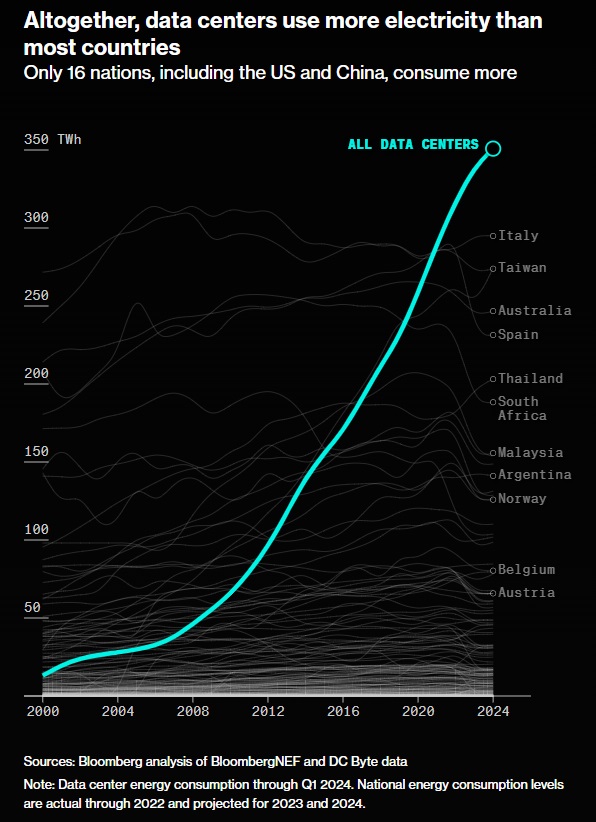“Energy is the golden thread that connects economic growth, social equity, and environmental sustainability.” – Ban Ki-moon
The rise of artificial intelligence is now turbocharging demand for bigger data centers……The almost overnight surge in electricity demand from data centers is now outstripping the available power supply in many parts of the world, according to interviews with data center operators, energy providers and tech executives. That dynamic is leading to years-long waits for businesses to access the grid as well as growing concerns of outages and price increases for those living in the densest data center markets….By one official estimate, Sweden could see power demand from data centers roughly double over the course of this decade — and then double again by 2040. In the UK, AI is expected to suck up 500% more energy over the next decade. And in the US, data centers are projected to use 8% of total power by 2030, up from 3% in 2022, according to Goldman Sachs, which described it as “the kind of electricity growth that hasn’t been seen in a generation.”
…Globally, there are more than 7,000 data centers built or in various stages of development, up from 3,600 in 2015…These data centers have the capacity to consume a combined 508 terawatt hours (THh) of electricity per year if they were to run constantly. That’s greater than the total annual electricity production for Italy or Australia. – Bloomberg
The average American home uses 30 kilowatt-hours (kWh) of electricity per day, totaling about 900 kWh per month and approximately 10,800 kWh per year. However, the power demand can increase significantly when multiple appliances are used simultaneously.
One terawatt-hour (TWh) of electricity can fully power 70,000 homes for a year, light over one million homes, or cool 500,000 homes for a year. A TWh is a unit of energy equal to one trillion watt-hours, or one billion kilowatt-hours. It is often used to measure large amounts of electricity or heat.

-
Watt
: A small unit of power. For instance, a small LED light bulb might use about 5 watts of power.
-
Kilowatt (kW): 1,000 watts. Household appliances are usually rated in kilowatts. For example, a typical microwave oven might use around 1 kW of power.
-
Megawatt (MW): 1,000 kilowatts or 1 million watts. Power plants are often rated in megawatts. A large wind turbine might have a capacity of around 2 to 3 MW.
-
Gigawatt (GW): 1,000 megawatts or 1 billion watts. Entire electrical grids or major power plants are sometimes rated in gigawatts. For example, the Hoover Dam has a capacity of about 2 GW.
-
Terawatt (TW): 1,000 gigawatts or 1 trillion watts. Terawatts are used to measure total energy consumption or production on a national or global scale. For instance, the total electricity consumption of the entire United States in 2021 was about 4 terawatt-hours (TWh) per day, which averages out to a continuous power consumption of about 167 TW.
-
Terawatt-hour (TWh): A unit of energy equal to one trillion watt-hours, or one billion kilowatt-hours. One TWh can power 70,000 homes fully for a year, light over one million homes, or cool 500,000 homes for a year.
A terawatt (TW) and a terawatt-hour (TWh) measure different aspects of energy. A terawatt is a unit of power, representing the rate at which energy is used or produced at a specific moment; for instance, a power plant operating at a capacity of 1 TW is producing one trillion watts of power continuously. On the other hand, a terawatt-hour is a unit of energy, representing the total amount of power consumed or produced over time; for example, if that power plant operates at 1 TW for one hour, it will generate 1 TWh of energy. In essence, terawatts measure power (instantaneous rate), while terawatt-hours measure energy (accumulated usage over time).


Pingback: BFTP: Greatest Arbitrage Ever | Global Macro Monitor